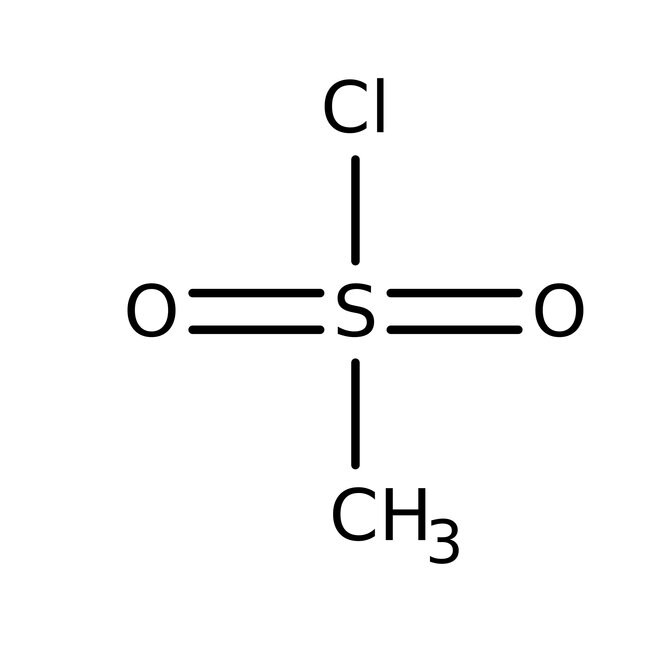Search Thermo Fisher Scientific
Methanesulfonyl chloride, 98%, Thermo Scientific Chemicals



Methanesulfonyl chloride, 98%, Thermo Scientific Chemicals
Chemical Identifiers
Specifications
Description
Methanesulfonyl chloride is used as a reagent for conversion of alcohols to mesylate esters such as methanesulfonate, which is an intermediate in substitution reactions, elimination reactions, reductions, and rearrangement reactions viz. Beckmann rearrangement. It is an electrophile and acts as a source of CH3SO2+ group. It is also used to prepare beta-chloro sulfones, methanesulfonamide and heterocyclic compounds containing five membered sultones.
This Thermo Scientific Chemicals brand product was originally part of the Alfa Aesar product portfolio. Some documentation and label information may refer to the legacy brand. The original Alfa Aesar product / item code or SKU reference has not changed as a part of the brand transition to Thermo Scientific Chemicals.
Methanesulfonyl chloride is used as a reagent for conversion of alcohols to mesylate esters such as methanesulfonate, which is an intermediate in substitution reactions, elimination reactions, reductions, and rearrangement reactions viz. Beckmann rearrangement. It is an electrophile and acts as a source of CH3SO2+ group. It is also used to prepare beta-chloro sulfones, methanesulfonamide and heterocyclic compounds containing five membered sultones.
Solubility
Miscible with alcohol, ether and organic solvents. Immiscible with water.
Notes
Moisture sensitive. Store in a cool place. Incompatible with strong bases, oxidizing agents and alcohols. It is a lachrymator and reacts with water.
Figures
Documents & Downloads
Certificates
Frequently asked questions (FAQs)
Citations & References
Safety and Handling
Classification of the substance or mixture
CLP classification - Regulation(EC) No 1272/2008
Label Elements
Signal Word
Danger
Hazard Statements
H301 + H311 - Toxic if swallowed or in contact with skin
H314 - Causes severe skin burns and eye damage
H317 - May cause an allergic skin reaction
H330 - Fatal if inhaled
H335 - May cause respiratory irritation
Physical hazards
H290 - May be corrosive to metals
Precautionary Statements
P280 - Wear protective gloves/protective clothing/eye protection/face protection
P301 + P330 + P331 - IF SWALLOWED: Rinse mouth. Do NOT induce vomiting
P303 + P361 + P353 - IF ON SKIN (or hair): Take off immediately all contaminated clothing. Rinse skin with water or shower
P304 + P340 - IF INHALED: Remove person to fresh air and keep comfortable for breathing
P305 + P351 + P338 - IF IN EYES: Rinse cautiously with water for several minutes. Remove contact lenses, if present and easy to do. Continue rinsing
P310 - Immediately call a POISON CENTER or doctor/physician